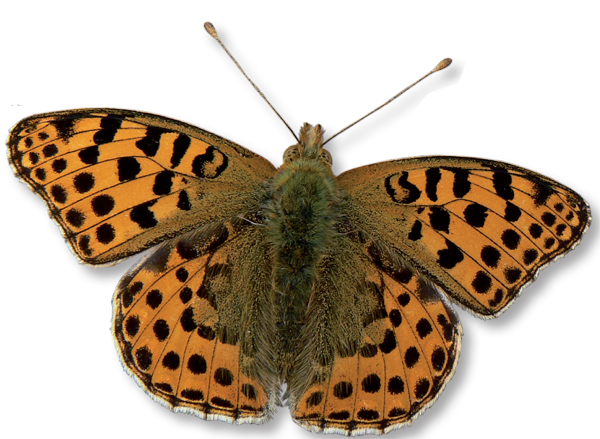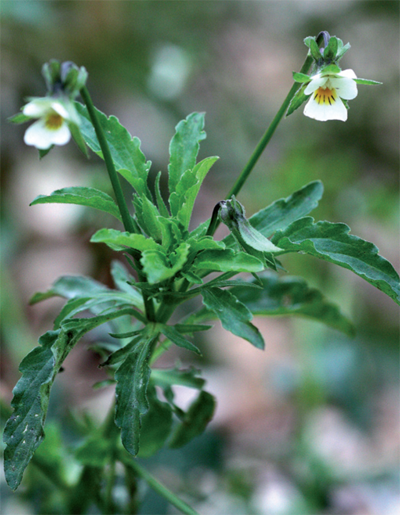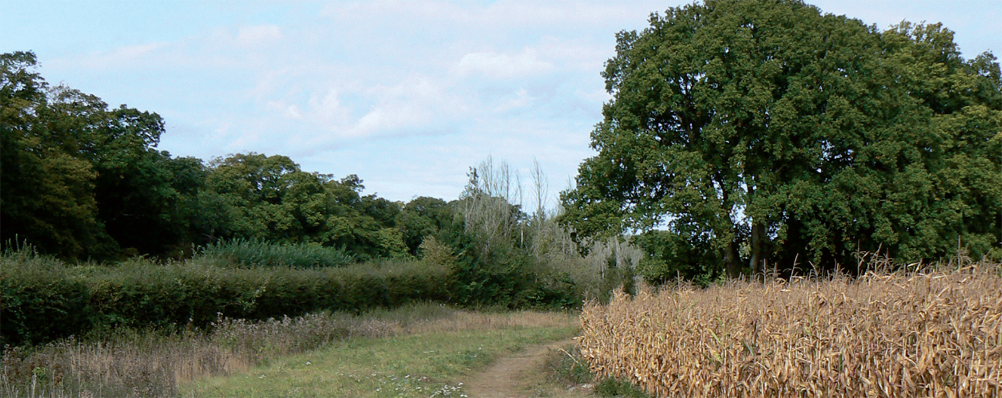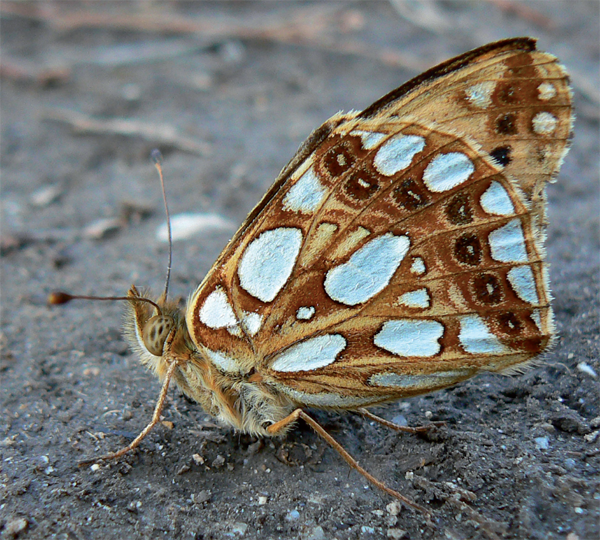Queen of Spain Fritillary in West Sussex
Evidence of breeding by The Queen of Spain Fritillary butterfly (Issoria lathonia Linn.) at Chichester, West Sussex in 2009
Originally published in the Spring 2010 Sussex Butterfly Report

Strong circumstantial evidence of breeding by the Queen of Spain Fritillary (Issoria lathonia) on the northwest fringe of Chichester, West Sussex in 2009 is presented, this being the third sequential year that the species has been recorded in the general area. The 8 or more adults observed from mid-September 2009 onwards are considered to probably represent the progeny of a single female butterfly, observed less than 500m away on 14th July 2009, although the presence of other egg-laying females in the area at that time cannot be precluded. This medium-sized butterfly is distinguished by the occurrence of large, metallic-silver spangles on the underside of the hind wings. The upper surface is a ginger brown colour, decorated with a quite variable pattern of black spots. The wing profile is also characteristic, giving an unusual ‘squared off’ appearance to the hind margins. It is a species of dry, dusty habitats and has only once been briefly tolerant of British winters, in Suffolk in the mid/late 1990s. The Queen of Spain Fritillary (Issoria lathonia) is a very scarce immigrant to the UK, and was first listed by James Petiver in 1702. Since then, fewer than 400 sightings have been made, mainly along the south coast. Colin Pratt (in prep.) collates approaching 50 Sussex records, but none from 1970 to 2006 inclusive. However, from 2007 onwards there have been a series of sightings in the Chichester area, with more elsewhere.
 Field Pansy
Field Pansy
In 2007 there was significant migration to the UK, this being a 60 year record high for Sussex. Moving from west to east along the south coast, Queen of Spain Fritillaries were seen at Old Winchester Hill (Henry Kemm, 13th June), Southbourne (Derek Coventry, 29th April), Kingley Vale National Nature Reserve (two seen by Brian Langmaid, 27th September), Springhead Hill (Eric and Neil Hulme, 18th April - earliest confirmed UK record) and Friston Forest (John Kirby, 25th September). Old Broyle Road (northwest Chichester) to the west and a maize field to the east. He reported seeing the first of them ‘up to a week earlier’. This area lies 300m to the south of an area of sweet chestnut coppice, forming part of the Brandy Hole Copse Local Nature Reserve. On receipt of the photographs, Mike Perry identified them all as Queen of Spain Fritillaries.
Mike Perry visited the site on 25th September and observed ‘five, possibly six’ Queen of Spain Fritillaries, which all appeared to be in excellent condition and freshly emerged. He ‘potted’ three specimens for independent confirmation of identity, later returning the live insects to the same location.
On 4th October Neil Hulme (NH) visited the site and identified four male and one female Queen of Spain Fritillary, on the basis of the smaller size and combative behaviour of four of the specimens. They readily attacked Clouded Yellow (Colias croceus), Red Admiral (Vanessa atalanta) and Painted Lady (Cynthia cardui). Repeated attempts at courting the female were resisted, suggesting that she had already mated.
The female was in perfect condition, showed no loss of scales or thoracic hair, and had probably emerged over the previous few days. All of the males showed very considerable ‘wear and tear’, including some damage that would have occurred in up to three of these specimens while ‘potted’. On 8th October NH observed five male Queen of Spain Fritillaries, including the four seen previously (now of very worn appearance) and a different specimen, which was still in excellent condition. A freshly-emerged, virgin female was subsequently seen by NH and others on 12th October. This pattern clearly demonstrates the staggered appearance of insects on the site.
Dealing firstly with the current batch of sightings, it is considered highly unlikely that they represent a group of recent arrivals from Europe. The initially pristine condition of all specimens (reported by John Kelsall and Mike Perry), the staggered appearance of individuals on the site and the ratio of male to female butterflies all argue against this. This leaves the possibilities of either a captive-bred release, or a natural emergence locally.
When considering the origin of a group of butterflies which occur as rarely as the Queen of Spain Fritillary, the potential for captive-bred release must be carefully considered, as the species is available from several suppliers of livestock. However, captive-bred releases are rare in Sussex, unlike in some areas of the UK where the practice is widespread. When such releases do occur, they usually involve a single episode of dumping of unwanted stock, after further breeding or retention for photography. Captive-bred butterflies often appear in less- than-ideal habitats and usually show some evidence (characteristic damage) of caging. The initially pristine condition of all specimens and the staggered appearance of individuals over a number of weeks suggest an alternative explanation.
 Brandy Hole Copse
Brandy Hole Copse
If these Queen of Spain Fritillaries were to represent a natural emergence on site, at least one gravid female butterfly must have previously passed through the area, at a time that suitably explains the appearance of a subsequent generation. On 14th July 2009 Robert Beale was walking through the Brandy Hole Copse Local Nature Reserve to the north, with a view to finding Purple Hairstreaks (Neozephyrus quercus). He paused briefly within the sweet chestnut coppice area to photograph a butterfly he initially believed to be either a High Brown Fritillary (Argynnis adippe) or Dark Green Fritillary (Argynnis aglaja). The images he submitted to the Butterfly Conservation Sussex Branch website were subsequently identified as being of a (probably female) Queen of Spain Fritillary by NH. NH made a thorough search of the entire area on 16th July in good weather and subsequently concluded ‘that the butterfly is a genuine migrant and has moved on’. This insect may have been in the area for some time before it was spotted by Robert Beale
Robert Beale’s sighting was in an area less than 500 metres away from the September and October butterflies, and the timing fits very well in explaining the latter as the progeny of Robert Beale’s insect. Zobar & Genc (2008) record a period as brief as 23 – 31 days for the complete life-cycle, under laboratory conditions at a mean temperature of 26°C.; in more southerly latitudes the life-cycle period is also shorter than would be expected in the UK. Given local climatic conditions, the apparent nine week (minimum) life-cycle here is very much in line with that which would be expected.
 The Queen of Spain Fritillary
The Queen of Spain Fritillary
The habitat where these latest sightings have occurred appears broadly suitable, although quite restricted in extent. It comprises the sheltered margins of a maize field (‘set aside’ until two years previously) with areas of stony, bare ground. The butterfly was also seen occasionally within the rough meadow immediately to the south of the Brandy Hole Copse Local Nature Reserve, known locally as ‘The Triangle’. This was the area in which courtship and copulation was observed on 12th October.
The preferred food-plants of the Queen of Spain Fritillary are field pansy (Viola arvensis) and wild pansy (V. tricolor), although in Europe the larvae will readily feed upon a number of species of violet (Tolman & Lewington, 1997). On 10th October, during a field outing to see the butterflies, Barbara Ottley identified field pansy between the maize stems along the western edge of the field. A further search by NH revealed that the plant is particularly abundant along the eastern margins of the maize field, extending some considerable distance into the crop.
The following observations were made by Neil Hulme:
- Abundance data (table above): A total of 8 different butterflies were observed by NH, differentiated on the basis of sex, ornamental variation and degree of ‘wear and tear’. This included 6 males and 2 females, the latter insects being far more secretive and difficult to observe.
- The emergence of this brood began on or soon after 15th September and the last butterfly was seen (unknown observer) on 1st November. The appearance of a ‘fresh’ female on or shortly before 12th October indicates a somewhat protracted period of emergence for the offspring of a single parent. However, the speed of development of the eggs (which are laid singly) and early stage caterpillars will vary considerably, according to the favourability of each individual oviposition site. This variation in speed of development would most likely have been exaggerated by falling (seasonal) temperatures, particularly during the later stage development of some less-advanced larvae and pupae. Detailed, unpublished studies of Purple Emperor (Apatura iris) caterpillars in the wild (performed by NH), demonstrate that periods of very rapid development can be followed by lengthy period of almost total arrestment, dependent upon prevailing weather conditions. This lengthy period of emergence is much more typical of butterfly development in the wild. Captive-bred insects are invariably raised under far more consistent conditions, leading to a more harmonised hatching of adults.
- On 12th October NH observed courtship and copulation of Queen of Spain Fritillaries, within ‘The Triangle’ area. A male butterfly had been holding territory here for most of the day, when a pristine female insect was spotted nearby at 15.30 hrs. She subsequently flew close to the male, which immediately flew up to meet her. Following a brief, tumbling, courtship flight they paired on the ground, later climbing onto low bramble leaves. Copulation lasted for 25 minutes, between 15.50 hrs and 16.15 hrs.
- The butterflies regularly roosted in low scrub, but were also seen retiring to the tops of both oak and sweet chestnut trees, at heights of approximately 15m and 20m respectively.
- The majority of the male butterflies demonstrated ‘lekking’ behaviour, congregating along a short section of footpath beside the maize field. Up to 5 males would collect here, constantly squabbling amongst themselves and attacking any other passing insects.
- On 10th October NH found the remains of a male butterfly, below an immature hazel where it had gone to roost on 8th October. Only the thorax had been eaten and predation by a spider seems most likely.
- The butterflies were seen nectaring at a variety of flowers, but seemed to show a preference for thistle.
Some consideration must also be given to the origin of Robert Beale’s Queen of Spain, sighted within Brandy Hole Copse on 14th July 2009. Although this might be explained as a recent immigrant, possibly sourced from the currently strong populations scattered along the Normandy coast (T. Brereton, pers. comm.), consideration of all the 2007 – 2009 Sussex records led Pratt & Hulme (2010, in press, Atropos 39) to draw an alternative conclusion. Given that the only 2008 Sussex sighting, following the 2007 influx, was also at Brandy Hole Copse, it perhaps seems more likely that the species has been continually present in the Chichester area for the last two years.

Although the 2007 (Sussex) influx comprised only 5 (definite) sightings, it is worth considering that the vast majority of these immigrant butterflies will always go unseen, unrecognised or unreported. Experiments performed in a densely populated area of Germany (Von Roer, 1970) showed that only 1-2% of marked and released Camberwell Beauties (Nymphalis antiopa) were subsequently observed and reported. Across more rural Sussex this figure might be lower, suggesting that in excess of 500 Queen of Spain Fritillaries may have been present in 2007.
It is considered very possible that a small population has persisted in this part of West Sussex, probably utilising ‘conservation headlands’ (less-intensively treated crop margins) across this largely arable landscape. One of the preferred food-plants, field pansy (Viola arvensis), is currently widespread on farmland around the Chichester area (B. Langmaid, pers. comm.).
The short-term fate of these insects may well depend upon the 2009/2010 winter weather; a combination of high humidity and cold apparently being fatal to their larvae. This species, which may diapause in either the egg, larval, pupal or adult stage (Tolman & Lewington, 1997), has historically failed to survive the British winter, although it appears to have done so for a couple of years at the Minsmere RSPB Reserve in Suffolk in the mid/late 1990s.
The immediate establishment of a longterm colony in this particular location seems doubtful. However, given the continuation of late 20th century changes in climate and European butterfly distributions, it is considered likely that Queen of Spain Fritillary colonies will eventually become established in this area of West Sussex and elsewhere within the South of England.
ACKNOWLEDGEMENTS
My thanks go to C. R. Pratt for his generous help and guidance in putting this account together, and for providing a historical perspective of the Queen of Spain Fritillary in Sussex. Thanks are also due to M. C. Perry and members of the Chichester Natural History Society for disseminating news of the initial sightings, and to all of the individual recorders who made these conclusions possible. These include B. Henham, who provided local weather reports throughout the flight period, the photograph of field pansy, and was amongst the privileged group that observed the fritillaries mating.
REFERENCES
Pratt, C. R., in prep. A Complete History of the Butterflies and Moths of Sussex. Booth Museum of Natural History, Brighton & Hove City Council.
Pratt, C. R. & Hulme, N. A. C., 2010, in press. The Queen of Spain Fritillary (Issoria lathonia Linn.) in Sussex during the 21st Century. Atropos 39.
Tolman, T. and Lewington, R., 1997. Butterflies of Europe. Princeton University Press. 310 pp.
Von Roer, H., 1970. Untersuchungen zum Migrationsverhalten des Trauermantels (Nymphalis antiopa L.). Z. Angew. Entomol. 65 (4). pp. 49-68.
Zobar, D. and Genc, H., 2008. Biology of the Queen of Spain Fritillary, Issoria lathonia (Lepidoptera: Nymphalidae). Florida Entomologist 91 (2). pp. 237-240.
Website: Butterfly Conservation Sussex Branch www.sussex-butterflies.org.uk
Website: Chichester Natural History Society http://www.chichesternaturalhistorysociety.org/#Home


